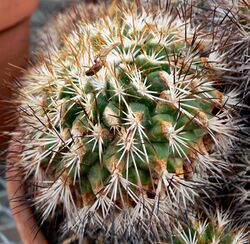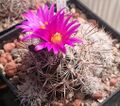Biology:Kadenicarpus horripilus
| Kadenicarpus horripilus | |
|---|---|

| |
| Scientific classification | |
| Kingdom: | Plantae |
| Clade: | Tracheophytes |
| Clade: | Angiosperms |
| Clade: | Eudicots |
| Order: | Caryophyllales |
| Family: | Cactaceae |
| Subfamily: | Cactoideae |
| Genus: | Kadenicarpus |
| Species: | K. horripilus
|
| Binomial name | |
| Kadenicarpus horripilus (Lem.) Vázquez-Sánchez[3]
| |
| Synonyms[3] | |
| |
Kadenicarpus horripilus is a species of plant in the family Cactaceae.[3]
It is an endangered species, threatened by habitat loss.
Description
Kadenicarpus horripilus often grows sprouting with olive-green, spherical to elongated spherical bodies and fibrous roots. The bodies reach growth heights of 7 to 18 centimeters and a diameter of 4 to 6.5 centimeters. Their clearly pronounced conical cusps are 5 to 7 millimeters high. The plant usually a single, protruding, straight, whitish central spine that is dark at the tip. It reaches a length of 12 to 18 millimeters. The 12 to 14 straight radial spines are white with a dark tip, protruding and 9 to 11 millimeters long.
The flowers are magenta with a white throat. They are 2.2 to 3.1 centimeters long and have a diameter of 2.5 to 3.5 centimeters. The elongated, greenish-red fruits turn yellowish-brownish when ripe. They are 4 to 6 millimeters long and reach a diameter of 3 to 5 millimeters.[4]
Distribution
It is endemic to Hidalgo state in Mexico. Its natural habitat is hot deserts.
Taxonomy
It was first described as Mammillaria horripila in 1838 by Charles Lemaire.[5] The specific epithet horripilus is derived from the Latin words horrere for 'shudder' and pilus for 'hair' and refers to the thorns of the species. Monserrat Vázquez-Sánchez placed the species in the genus Kadenicarpus in 2019.[6] Further nomenclature synonym are Echinocactus horripilus (Lem.) Lem. (1839), Neolloydia horripila (Lem.) Britton & Rose (1923), Gymnocactus horripilus (Lem. ex C.F.Först.) Backeb. (1951), Thelocactus horripilus (Lem.) Kladiwa (1970), Thelocactus horripilus (Lem.) Kladiwa & Fittkau (1975), Turbinicarpus horripilus (Lem.) V.John & Říha (1983), Bravocactus horripilus (Lem.) ( 1998) and Pediocactus horripilus (Lem.) Halda (1998)
References
- ↑ Guadalupe Martínez, J.; Fitz Maurice, W.A.; Fitz Maurice, B (2013). "Turbinicarpus horripilus". IUCN Red List of Threatened Species 2013: e.T40977A2948794. doi:10.2305/IUCN.UK.2013-1.RLTS.T40977A2948794.en. https://www.iucnredlist.org/species/40977/2948794. Retrieved 15 November 2021.
- ↑ "Appendices | CITES". https://cites.org/eng/app/appendices.php.
- ↑ Jump up to: 3.0 3.1 3.2 "Kadenicarpus horripilus (Lem.) Vázquez-Sánchez". Plants of the World Online. Royal Botanic Gardens, Kew. https://powo.science.kew.org/taxon/urn:lsid:ipni.org:names:77201705-1.
- ↑ Anderson, Edward F.; Eggli, Urs (2005) (in de). Das grosse Kakteen-Lexikon. Stuttgart (Hohenheim): Ulmer. p. 630. ISBN 3-8001-4573-1.
- ↑ Lemaire, C.A. (1838) (in la). Cactearum aliquot novarum ac insuetarum in horto Monvilliano cultarum accurata descriptio: fasc. 1. Apud F. G. Levrault. p. 7. https://books.google.com/books?id=gZQaAAAAYAAJ&pg=PA7. Retrieved 2023-12-03.
- ↑ Vázquez-sánchez, Monserrat; Sánchez, Daniel; Terrazas, Teresa; De La Rosa-Tilapa, Alejandro; Arias, Salvador (2019-07-10). "Polyphyly of the iconic cactus genus Turbinicarpus (Cactaceae) and its generic circumscription". Botanical Journal of the Linnean Society (Oxford University Press (OUP)) 190 (4): 405–420. doi:10.1093/botlinnean/boz027. ISSN 0024-4074.
External links
Wikidata ☰ {{{from}}} entry
 |




